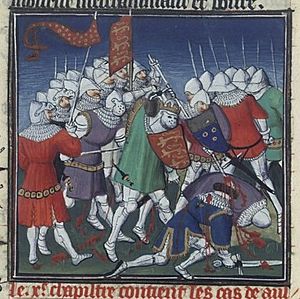Battle of Tinchebray facts for kids
Quick facts for kids Battle of Tinchebray |
|||||||
|---|---|---|---|---|---|---|---|
| Part of Henry I's invasion of Normandy | |||||||
 Late medieval picture from the 15th century of the Battle of Tinchebray, by the Rohan Master |
|||||||
|
|||||||
| Belligerents | |||||||
| Forces of Robert Curthose, the Duke of Normandy | Forces of Henry, King of England | ||||||
| Commanders and leaders | |||||||
| Robert Curthose, Duke of Normandy (POW) William, Count of Mortain (POW) Robert of Bellême, 3rd Earl of Shrewsbury Edgar Atheling (POW) |
Henry I of England Ranulf of Bayeux Robert de Beaumont, Count of Meulan William de Warenne Elias I of Maine Alan IV, Duke of Brittany William, Count of Évreux Ralph of Tosny Robert of Montfort Robert of Grandmesnil |
||||||
| Strength | |||||||
|
Total: 6,700
|
Total: +6,700
|
||||||
| Casualties and losses | |||||||
|
Captured:
Killed:
|
Henry's claim: 2 knights |
||||||
The Battle of Tinchebray was a big fight that happened on September 28, 1106. It took place in a place called Tinchebray, which is now in France. This battle was between two brothers: King Henry I of England and his older brother, Robert Curthose, who was the Duke of Normandy.
King Henry's army won a huge victory. They captured Robert, and Henry kept him in prison for the rest of his life. This battle was very important because it meant King Henry I gained control of both England and Normandy.
Contents
Why the Battle Happened: A Family Feud
This battle was part of a long fight between King Henry I and his brother, Robert Curthose. They were both sons of William the Conqueror, who had taken over England in 1066. After their father died, they argued over who should rule his lands.
Robert became the Duke of Normandy, and Henry became King of England. But Henry wanted to control Normandy too. This led to several conflicts between the brothers.
Henry's Invasion of Normandy
In 1105, King Henry I decided to invade Normandy. He captured important cities like Bayeux and Caen. However, he had to stop his campaign for a while. There were some political problems in England that needed his attention.
Once those problems were sorted out, Henry returned to Normandy in the spring of 1106. He quickly took over a strong abbey (a type of monastery) called Saint-Pierre-sur-Dives. Then, he moved his army south.
The Siege of Tinchebray Castle
Henry's next target was Tinchebray Castle. This castle was on a hill above the town of Tinchebray. It was a very important location because it was on the border of a county called Mortain. The castle was held by William, Count of Mortain. He was one of the few powerful Norman leaders who was still loyal to Duke Robert.
Duke Robert brought his army to Tinchebray to try and stop Henry's attack on the castle. They tried to talk things out, but they couldn't agree. So, Duke Robert decided that fighting an open battle was his best chance to win.
The Battle Begins
King Henry's army was set up in three main groups. Two of these groups were led by important commanders: Ranulf of Bayeux and Robert de Beaumont, 1st Earl of Leicester. Another group was led by William de Warenne, 2nd Earl of Surrey.
A third group, which was a reserve force, stayed hidden. This group was commanded by Elias I of Maine. Other important leaders like Alan IV, Duke of Brittany, and William, Count of Évreux also fought with King Henry. On Duke Robert's side, William, Count of Mortain and Robert of Bellême, 3rd Earl of Shrewsbury were his main supporters.
An Unusual Tactic
The battle itself only lasted about an hour. King Henry did something unusual for Norman battles: he told most of his knights to get off their horses and fight on foot. This meant that the foot soldiers (infantry) played a very important role in the battle.
The hidden reserve group, led by Elias I of Maine, ended up being very important. They attacked from the side and helped Henry's army win the fight.
What Happened After the Battle
Most of Duke Robert's army was either captured or killed. Duke Robert himself was captured. So were Edgar Ætheling, who was the uncle of Henry's wife, and William, Count of Mortain.
Robert de Bellême, who was in charge of Duke Robert's rear guard (the soldiers at the back), managed to escape. He led the retreat and avoided being captured or killed. Most of the other captured soldiers were later set free. However, Duke Robert Curthose and William of Mortain spent the rest of their lives in prison.
Duke Robert had a son named William Clito. Even after his father was imprisoned, William Clito tried to claim the Duchy of Normandy. This led to more rebellions against King Henry I for many years.
King Henry I ruled both England and Normandy until he died in 1135. The Battle of Tinchebray was a key moment that helped him keep control of both lands.
Tinchebray in Stories
The Battle of Tinchebray has appeared in some stories and games:
- The historical novel Knight's Fee by Rosemary Sutcliff, written in 1960, includes the battle.
- The video game Age of Empires IV has a part where you can play as King Henry's army in the Battle of Tinchebray.

